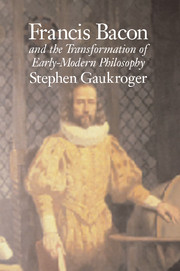Book contents
- Frontmatter
- Contents
- Acknowledgments
- References to Bacon's works
- Prologue
- 1 The nature of Bacon's project
- 2 Humanist models for scientia
- 3 The legitimation of natural philosophy
- 4 The shaping of the natural philosopher
- 5 Method as a way of pursuing natural philosophy
- 6 Dominion over nature
- Conclusion
- Bibliography
- Index
5 - Method as a way of pursuing natural philosophy
Published online by Cambridge University Press: 12 January 2010
- Frontmatter
- Contents
- Acknowledgments
- References to Bacon's works
- Prologue
- 1 The nature of Bacon's project
- 2 Humanist models for scientia
- 3 The legitimation of natural philosophy
- 4 The shaping of the natural philosopher
- 5 Method as a way of pursuing natural philosophy
- 6 Dominion over nature
- Conclusion
- Bibliography
- Index
Summary
The ‘Great Instauration’
When Novum Organum was first published in 1620, among the various short pieces with which it was prefaced was a general plan of the parts of the projected ‘Great Instauration’. This Distributio Operis divides the project into six parts. The first, which Bacon describes as ‘a summary or general description of the knowledge which the human race at present possesses’, was entitled ‘division of the sciences’, which had been the theme of the Advancement of Learning, and would be covered in a comprehensive way in the revised Latin version, De Dignitate & Augmentis Scientiarum. The latter was written for a continental audience and revised accordingly, and it was indicative of Bacon's realisation that little was likely to be done to implement his scheme in England, and of his desire to reach a wider audience.
The second part is ‘the New Organon, or Directions concerning the Interpretation of Nature’. The aim here is to equip the intellect to pass beyond what is already known. It is covered in Novum Organum, and although much earlier work on method is incorporated into Novum Organum, its detailed and comprehensive treatment makes it invaluable, and it has been widely regarded as Bacon's principal lasting contribution to natural philosophy – an assessment which I believe is entirely correct. Nevertheless, it is incomplete and was clearly intended to comprise more than the two books which Bacon managed to complete: In Book 2, he sets out nine major topics he will take up, the first seven of which seem relevant to the second part of the project, but he deals only with the first of these.
- Type
- Chapter
- Information
- Francis Bacon and the Transformation of Early-Modern Philosophy , pp. 132 - 165Publisher: Cambridge University PressPrint publication year: 2001



